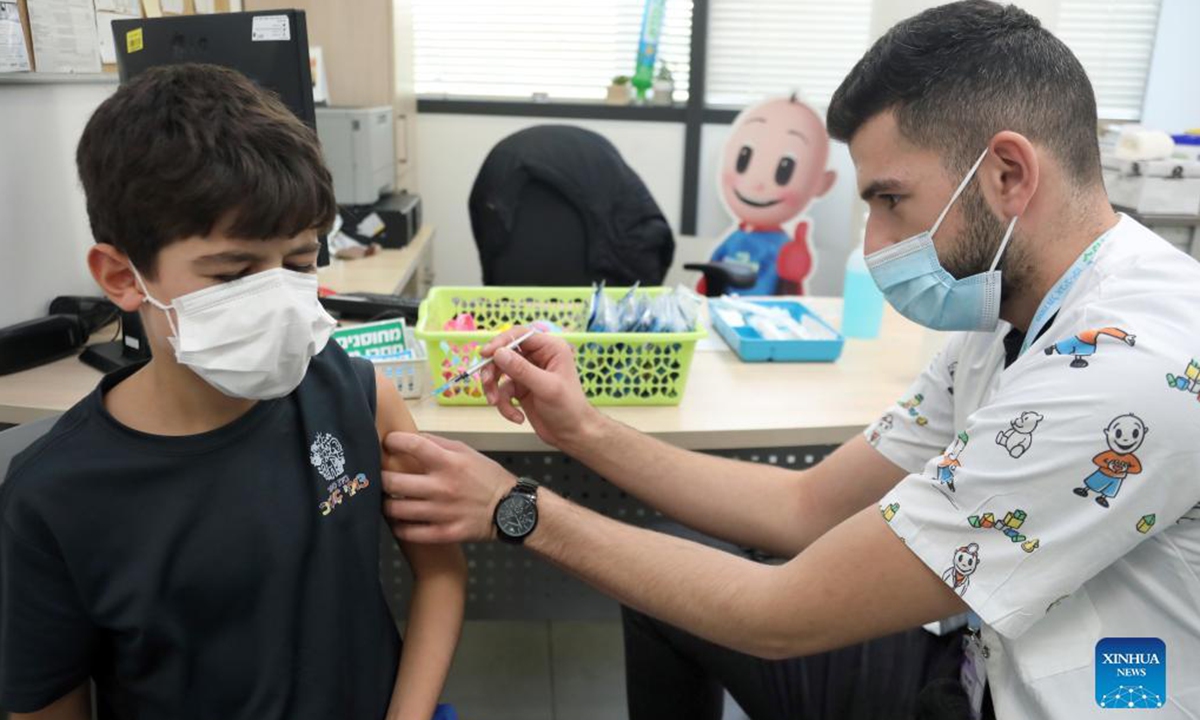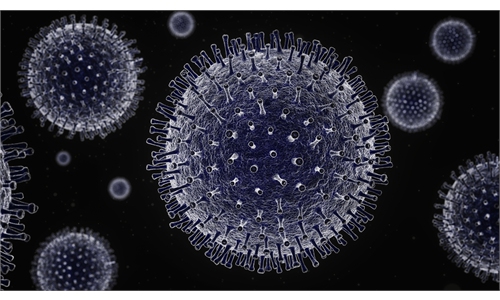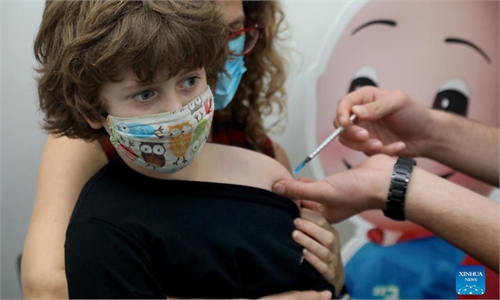Further study urged to find cause of acute hepatitis among children in over 30 countries, and its possible link to mRNA vaccine

A child receives the COVID-19 vaccine in Tel Aviv, Israel, on Nov. 25, 2021. Photo: Xinhua
In early April, the World Health Organization (WHO) was notified of a cluster of a severe acute hepatitis of unknown etiology in children under the age of 10 across central Scotland, of whom one had an onset of symptoms as early as in January 2022. As of May 26, more than 650 probable cases (with scattered death cases) have been reported in at least 33 countries. The unexpected hepatitis outbreak has triggered a high alert within the international community and has captured the attention of relevant researchers.
Cases of this hepatitis outbreak are increasingly being reported in many countries, the undetermined cause notwithstanding: We are dealing with a puzzling disease that disproportionately affects children. Previous bits of research however suggest that severe acute hepatitis is rare in children. According to WHO, the priority is to determine the cause of illness to further refine control and prevention measures. It takes time as well as a scientific precision. As a matter of fact, people are waiting for more information to aid in the fight against the disease.
Further information is needed
So far, experts have come up with a variety of hypotheses as to the origin of the confirmed cases, whereas more information and research is needed to make further determinations.
Based on data from the current global investigation and comprehensive public information from EU and UK authorities, the adenovirus has been pinpointed as the possible culprit in 75 percent of the cases tested in the UK, with a majority being confirmed to have Type 41 adenovirus. Strangely, Type 41 adenovirus infection has not previously been linked to similar clinical presentation in otherwise healthy children. In terms of the WHO latest risk assessment, the current apparent association identified with adenovirus could be an incidental finding due to enhanced laboratory testing in association with increased levels of community transmission of the adenovirus.
A recent study from Germany has revealed that the COVID-19 mRNA vaccine is likely to induce T-cell-dominated autoimmune hepatitis. Further research is required to find out whether there is a link between the mRNA vaccine and acute hepatitis.
Some experts also believe that the mix of multiple etiologies engenders this acute hepatitis. For instance, a super-antigen caused by a co-infection by the novel adenovirus and SARS-CoV-2 or a complication from a previous SARS-CoV-2 infection is under investigation.
Medical circles are divided on the cause of the disease, and it is possible to ignite sensationalism among the public. Due to a lack of information, the possibility of any hypothesis infection should not simply be ruled out, nor should a certain one be anticipated only in a bid to divert public attention, for fear of any "hasty generalization." As WHO encourages further detailed epidemiological, clinical, laboratory, histopathological, and toxicological investigations of the possible cause(s) of these cases, it is imperative that any probable pathogen be verified in a scientifically rigorous manner.
Timely origin-tracing could play a role
On account that many countries have just gotten started on ramping up surveillance on this unexplained hepatitis strain the current number of confirmed cases and deaths merely tell a small part of a larger story.
With an increase in reported cases, there is evidence that this hepatitis strain infection might have first occurred earlier than January this year. A recent Morbidity and Mortality Weekly Report published by the American Centers for Disease Control and Prevention gives related findings: Between October and November 2021, a children's hospital in Alabama received and treated five children with severe hepatitis and adenovirus viremia.
It has been several months since the earliest case was identified. Practically speaking, early case samples are of great scientific value for purposes of clarifying the cause of the hepatitis strain, but time is of the essence. Given the insufficient information on detection and unclear transmission modes, making good use of early cases enlarges the reliability of research results. WHO is supporting countries with ongoing investigations and the collecting of information from countries reporting cases. In this regard, WHO is supposed to send an international group of experts to affected areas to conduct field investigations and origin-tracing providing for a more coherent public narrative. Countries plagued by the hepatitis of unknown origin are expected to take the initiative to share information, including but not limited to gene sequencing, so as to help more countries shake off or avert the plight.
Enhanced prevention and control measures may work
Previous studies have shown that there are multiple causes of acute hepatitis infections in children, among which the digestive tract and blood are main routes of transmission. The adenovirus is also contagious. Thus, despite the transmission modes of this hepatitis remaining surreptitious, it may still bear certain infectiousness. WHO suggested that human-to-human transmission cannot be ruled out as there have been a few reports of epidemiologically linked cases. Perhaps the tag of "unknown origin" has terribly frightened a fair number of people. Be that as it may, it should be taken into account that most countries around the world have not yet seen probable cases hence panic is unnecessary.
For China, both the experience accumulated in domestic COVID-19 response and the improvement of public awareness to health protection is of considerable benefit to the prevention of the spread of this unknown hepatitis strain. China's anti-COVID measures in key areas covering protection, quarantine measures, detection, treatment, and tracing, have effectively curbed the spread of the virus. Many epidemiologists believe that China's current measures provide a shelter for vulnerable groups like underage children, on the grounds that they are less exposed to potential dangers such as hepatitis. Notably, WHO advises the public to avoid crowded spaces and maintain social distancing, and wear a well-fitted mask covering the mouth and nose.
Proactive and effective responses reflect the spirit of putting people and life first. It was reported that a 3-year-old girl called Lola in the UK suffered from acute liver failure after contracting the disease and was dying. However, thanks to a liver transplant, she survived the disease.
Certainly, the sudden outbreak of this acute hepatitis strain is blight onto many people's lives. The children who died of the hepatitis strain are a source of everlasting pain for their bereaved families. Conversely those who undergo liver transplant need to take anti-rejection medicines and need to have regular check-ups for an extended period of time, and the operation scars permanently etched on their skin imprint this hurtful memory.
WHO is calling on all countries to work together to build a hepatitis-free future by 2030. This is not only a well-intentioned WHO appeal but a mutual global ambition. Further rigor is needed in carrying out scientific origin-tracing in countries and regions that first reported confirmed cases. More countries have been obliged to speak out on this health emergency, calling for a collaborative effort with greater attention paid to any feasible prevention measures and treatment plans as soon as possible. For those who suffer from this disease, and for those who are living in a state of panic spurred by fears of infection, this current hepatitis strain is likely to test the efficacy of the global scientific community.
The author is a commentator on international affairs. opinion@globaltimes.com.cn


